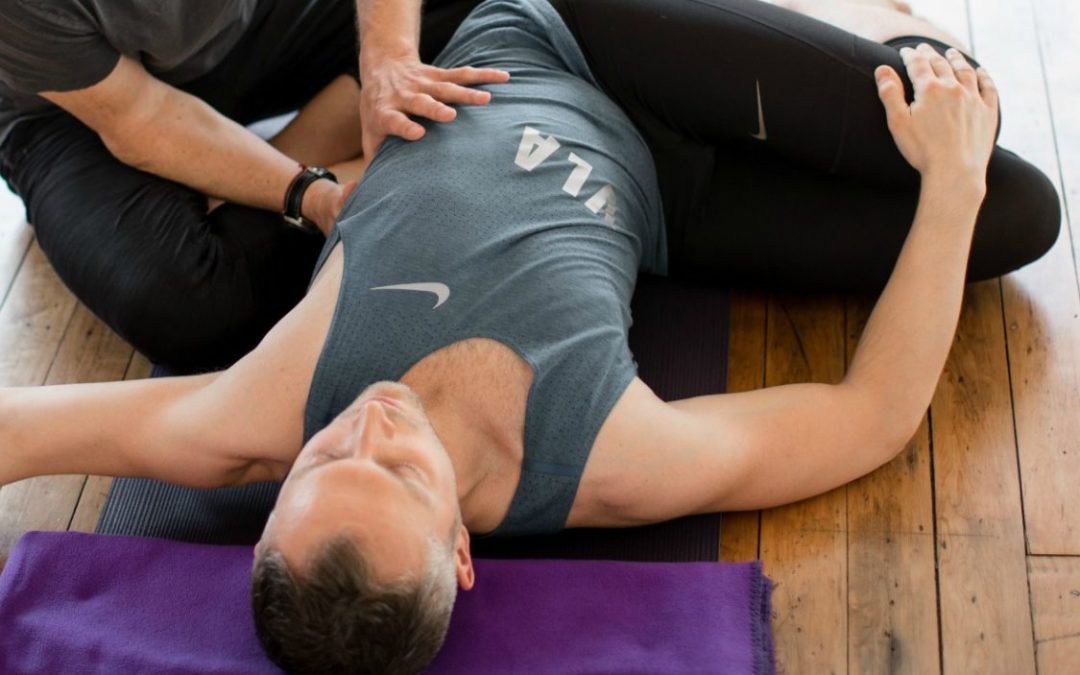If you are just starting out on your yoga journey, you may be surprised to hear that yoga can put stresses and strains on the body. Isn’t yoga a gentle, healing, positive, mindful practice ? As an osteopath as well as a yoga teacher, I am used to seeing yoga-related injuries in shoulders, backs, necks and beyond – they aren’t as uncommon as you might think. The good thing is, you can do a lot to help keep yourself out of my clinic.
Here are my 10 Top Tips for a safe practice:
- Know that Yoga centres aren’t gyms
Yes, a regular yoga asana practice will change your body. But so will any other physical activity if you do it enough. The important difference with Yoga is that it’s not just about throwing shapes – the whole point is that it also changes your MIND. One definition of yoga is ‘Yoga Citta Vritti Nirodha’ (“Yoga is the cessation of the fluctuations of the mindstuff”). The physical practice, undertaken calmly, systematically and with a dedicated intention, changes the whole body and mind. That’s the difference between ‘just’ exercise and yoga, and why yoga class gives you some mental space too. Embrace the sweat by all means, but know that’s not just why Yoga makes you feel different.
- Know and Respect YOUR body
“She can do the splits, I can’t.” Who cares ?! The person on the mat next to you might have been practicing yoga for 1 week, 20 years or 100 lifetimes. You have no idea – so don’t try to copy them. Practice the yogic behaviour of Satya (Truthfulness) and work within the limits of YOUR body’s limits and capability. Your body will change but don’t push it to do things it can’t yet. Work at your own pace. Do the modifications suggested by the teacher and choose the right class level. No one is going to give you a medal for doing the splits. Not yet anyway.
[More technical stuff: In particular: Physiologically, we are all on a stiff / bendy spectrum. Those of us with stiffer muscles need to stretch more. Those who are already bendy DO NOT need to stretch more – they need to strengthen their muscles. Know where you are – talk to your teacher.]
- Talk to teacher
Please, please, please… Tell your teacher if you have an injury, medical complaint, recent surgery etc. Certain postures are NOT SUITABLE for certain conditions and we really need to know. You don’t need to stand up and make a public announcement – come to class early and have a quiet word, or beckon the teacher over. We can give you modifications to postures, or may even suggest a different class. If you provide us with the info, we can help you stay safe. Don’t be shy. Ask for help.
- Learn Stuff
If I gave you a violin today, you wouldn’t be able to fiddle out a tune straight away, without a teacher and some practice. Why should Yoga be any different ? BKS Iyengar (a teacher revered in the yoga world) said we are all beginners for at least the first 2 years. Yoga teachers are there to teach and guide you as you start your journey. Sign up for a beginners course to learn the basics. USE YOUR TEACHERS: Teachers at Triyoga will have been teaching for at least 5 years, and practicing for many more. Ask us for clarification, soak up our knowledge, we love to help !
- Be present
Mindfulness and Yoga are spiritual bedfellows (quite literally – look it up!). Learn to be present in your physical practice. If your body is tired, or your shoulder is hurting, treat it respectfully in class. When we aren’t paying attention is when injuries happen. There is a difference between stretching sensations and pain. Be aware of what you are doing in each moment.
- Don’t overdo it
If you start training for a marathon having never run before and run 10 miles a day for the first 30 days, you would be surprised NOT to hurt yourself. “All you can eat offers” are not always good for your health – either in the supermarket or in a yoga centre. A class a day, if you are new to this type of practice, might put strain on your body, so moderate your participation if needed. Another behaviour from Hindu and Yoga Scripture is ‘Ahimsa’ or non-violence. It’s not just about not eating animals, it’s also about not being violent to yourself. . .
- Mix it up
Repetitive movements can cause injury (too much typing, lifting or yoga !) Try different styles to give your body different challenges and reduce the load. IN PARTICULAR, if you love Vinyasa / flow yoga, be aware that there can be a lot of strain put through low backs and shoulders. Until your body has been strengthened and conditioned to do this repetition, practice different styles. That is what the Intro offer is for. Try different styles of yoga with different teachers. A good yoga centre is a buffet – and variety is the spice of life.
- Have a rest day
Yes, a good sweat makes you feel good. But No, your burgeoning practice will not be affected by taking a day off from Chaturanga. Even Olympic athletes have a rest (I work with one, I know). Try quieter, meditative practices: Restorative, Meditation, Pranayama, Kirtan. Something where you don’t work the body but instead work your mind. Yin is still Asana.
- It’s YOUR YOGA NOT MY YOGA
In any class, remember: YOU are responsible for your body. The experience you are having is different to everyone else. If you need to rest, REST. If something hurts, STOP and ask (yourself, the teacher) why.
- Have fun and smile
This all sounds a bit serious. Just apply a bit of common sense, practice responsibly and listen to your body so you can get the best out of the amazing practices in the Yoga world. Yoga creates space – space in your body, mind, breath and personality – and space gives us the freedom to be happy, kind and to SMILE – inside and out. Enjoy yourself !!!
Anji is a Yoga teacher and Osteopath working privately and in the NHS. She has been practicing yoga for over 25 years, undertook teacher training in 2007 and teaches at Triyoga Ealing. She has a particular interest and specialism in using Yoga as a therapeutic tool to help relieve Persistent Low Back Pain and is grateful to have been able to help many students, patients and clients over the years. This Blog post was first published at https://triyoga.co.uk/blog/yoga/do-no-harm-a-mantra-for-yogis-not-just-medics/

